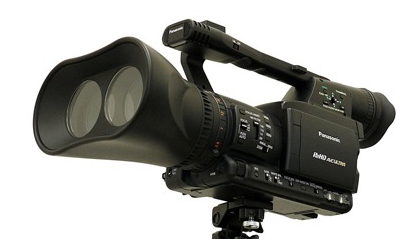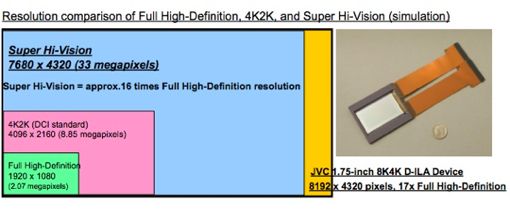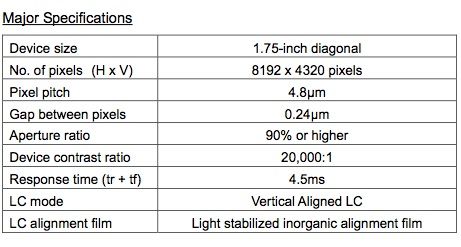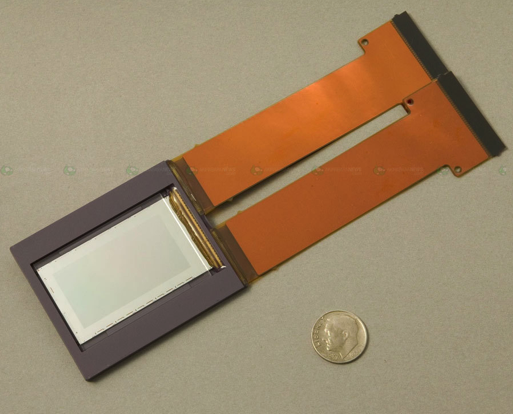Panasonic stellt 3D-HD-Kamera vor

Für das Anzeigen der Videos plant Panasonic die Herstellung eines 3D-Plasma-Displays. 3D könnte auch der Blu-Ray einen Schub geben: Die Scheiben bieten genug Platz für einen zweiten Videospur, nicht kompatible Player spielen dann eben nur eine Spur ab und zeigen somit den Film in 2D. Als Alternative zum Plasma-Display bieten sich Shutterbrillen an, aber 3D-Filme werden sicher erst dann den Massenmarkt erreichen, wenn sich Zuschauer keine spezielle Brille aufsetzen müssen.
An 3D-Technik wird bereits seit Jahren geforscht, alle paar Jahre versuchen sich Fernsehsender an Sendungen mit 3D-Szenen und verteilen dafür Pappbrillen. Die derzeitigen Bemühungen der Industrie sind aber deutlich vielversprechender. Pixar hatte beispielsweise letztes Jahr angekündigt, Animationsfilme beginnend mit "Up" sowohl im 2D- als auch 3D-Format zu veröffentlichen.
Industries First System to Support Efficient Production of 3D Full HD Content
announced it will start developing a professional 3D Full HD production system. The system, which will be the first of its kind in the industry, consists of a twin-lens P2 professional camera recorder and a 3D-compatible High Definition Plasma display. Panasonic will exhibit concept models of the 3D system at its booth (Central Hall #3712) at NAB 2009 to be held in Las Vegas, Nevada from April 20, 2009.

With Hollywood studios moving towards creation of more 3D entertainment content, Panasonic successfully debuted the world's first 3D Full HD Plasma Home Theater System based on Plasma display and Blu-ray Disc technologies at the CEATEC trade show in Japan in September 2008. More recently, the company also established the Advanced Authoring Center within Panasonic Hollywood Laboratory in February 2009 to support Hollywood studios in developing 3D Full HD Blu-ray Disc titles.
Production of 3D movies requires a great deal of time and effort. With the new 3D production system, which can enable an easier and more efficient 3D production process and environment, Panasonic will contribute to accelerating the realization of easier high-quality 3D content production.
At present, 3D content producers have to hand-build their own 3D production systems by physically connecting multiple 2D production devices. Panasonic is now starting to work on developing a twin-lens, 3D camera system. Also, Panasonic’s Plasma displays have been used in many post-production facilities in Hollywood, thanks to their high-quality imaging performance, which has been endorsed by leading Hollywood professionals. Technologies and expertise obtained from their use in post-production has enabled Panasonic to further develop high-quality 3D viewing performance in its Plasma technologies. As a result of this process, Panasonic’s 3D Plasma display system will help 3D content producers to quickly and easily evaluate the image quality of 3D content.
Each component of Panasonic’s innovative 3D Full HD production system has unique features. The twin-lens P2 camera recorder enables the capturing of natural and high-quality live 3D images. Thanks to the non-mechanical solid-state construction of the P2 system, the camera recorder will be compact enough to allow more flexible 3D shooting, thereby maximizing the creativity of the filmmakers by eliminating the stress factor from the use of the equipment.
3D Full HD recording using Panasonic’s proprietary P2 system also enables recording of two channels of Full HD images on the P2 card. P2’s non-mechanical construction and compactness will also be incorporated into the company’s 3D image recording and editing equipment to make production in the field highly flexible and efficient. Panasonic’s 3D Drive System enables the display of Full HD moving pictures for the left and the right eyes, so large screen 3D viewing will become possible. The excellent moving picture performance and accurate color reproduction characteristics achieved by Plasma’s self-illuminating technology enables the realization of high-quality 3D image evaluation capabilities required in the professional content production field.
“Panasonic is continuing its efforts to enable consumers to enjoy 3D movies in the comfort of their own living rooms with its 3D Full HD Plasma Home Theater System, which incorporates a Plasma HDTV and a Blu-ray Disc player,” said Dr. Paul Liao, Chief Technology Officer of Panasonic Corporation of North America. “The professional 3D Full HD image production system we are going to develop will improve the 3D production environment and accelerate creation of 3D titles.”
Super High Vision Single Display from JVC
If we have yet to see this resolution on upcoming video projectors, I'll bet such a resolution will soon be a reality... We just hope that something like the Red Video camera will also soon be accessible to us all!


Victor Company of Japan, Ltd. (JVC) announces a new addition to its lineup of proprietary D-ILA (Direct-Drive Image Light Amplifier) high-definition reflective liquid crystal devices for projectors. The newly developed 1.75-inch 8K4K D-ILA device has the world's largest number of pixels and is able to display images of approximately 35 megapixels (8192 x 4320 pixels), the equivalent of more than 17 times the level of Full High-Definition. This means that a single display device can now produce Super Hi-Vision images and can display images with the highest number of pixels currently defined under international standards.
After JVC developed the initial 7.86-megapixel (3840 x 2048 pixels) 4K2K D-ILA device in the summer of 2003, it subsequently further evolved the technology for highly realistic, high-definition images through a range of test viewings and verification testing, resulting in the development of JVC’s first commercial 4K2K D-ILA device (1.7-inch device size, 5,000:1 device contrast ratio) and the 4K2K D-ILA projector incorporating that device in September 2004.
In June 2007 JVC developed a 1.27-inch 4K2K D-ILA device that was the world's smallest device of its kind, having a 6.8µm pixel pitch and 4096 x 2400 pixels, and in February 2008 it began marketing a newly commercialized professional D-ILA projector, DLA-SH4K, incorporating that device.
Through the development of a new production process and new pixel structure for even finer pixels, JVC has now succeeded in developing the 1.75-inch 8K4K D-ILA device, the world's first device to achieve real Super Hi-Vision definition level. The new device has approximately 50% higher density in its ratio of area per pixel as compared to the 1.27-inch 4K2K D-ILA device, which was originally the world's smallest 4K device. Furthermore, the new device has achieved a video display of approximately 35 megapixels, the world's highest pixel counts, while continuing to provide the D-ILA series' characteristics such as “high-quality images without a distracting pixel structure”, “high light availability”, and “high contrast ratio”.
NASA sees potential in Immersive Visualisation
Absorbing the Big Picture: Immersion and Interactivity in Science Education
Rapid advancements in communication technologies are enabling unprecedented opportunities for science outreach and education. High-speed networks, video game engines, scientific visualization toolkits, geospatial viewers, innovative input devices, and immersive digital displays are increasingly at the disposal of both formal and informal education specialists. However, new technologies too often provide little more than temporary novelty if they're not thoughtfully integrated with other pedagogical elements to create meaningful and compelling experiences.
In this lecture/presentation, David McConville will illustrate the ways in which new interactive technologies and spatially immersive displays can be utilized to more fully engage students and the public in the science education process. Applying findings from cognitive psychology, gaming theory, and experiential education research, he will demonstrate how new collaborative and socially-oriented visualization tools have the potential to enable more intuitive and self-directed learning for students, scientists, policy makers, and the public.
About The Speaker
David McConville is a media artist and researcher focused on the development of the most compelling uses of immersive virtual environment displays. He is the co-founder and Director of Noospheric Research of The Elumenati, a full service design and engineering firm specializing in the development and deployment of immersive visualization experiences. The Elumenati provides systems integration, real-time software design, immersive content research, custom fabrication, and optical engineering for broad range of clientele. David holds a BSc in Music and Audio Engineering from the University of North Carolina Asheville, and he is currently a PhD candidate through the Planetary Collegium at the University of Plymouth.
Off Site Access Watch this presenation here. NOTE: You will need to have Microsoft MediaPlayer installed to view this presentation.
Download the presentation as a PDF for free:
"Absorbing the Big Picture: Immersion and Interactivity in Science Education" (44.6 MB)
2. Workshop in Immersive Cinema
International speakers this year will be Dr. Carter Emmart (American Museum of National History), Dr. Gill Russel (CosmicSky), Benjamin Crabut (RSA Cosmos), Lars Lindberg Christensen (ESA), Luis Calcada (ESO), Michael Daut (Evans & Sutherland), David McConville (Elumenati Inc.), Tom Kwasnitschka (AllSky.de), Staffan Klashed (SCISS) and Martin Howe (SEOS).
More information at http://fulldome.multimeios.pt
Cinema has always been a unique way to present audiences with memorable and unparalleled experiences. Its popularity is unquestionable and it seems to be, among all the art forms, the most consensual and the one able to captivate a public of all tastes, ages and backgrounds The advance in technology has naturally pushed cinema to the digital era. The quality of the images and the tools available to capture and project them are increasing. Going to the movies is more and more a unique experience, the images are becoming more and more clear and realistic, and the digital effects give the spectator strong sensations and create in the audiences the desire for other kind of film formats.

Digital cinema opened new horizons in film production: new techniques, new audiences, new languages make films more and more all embracing, easier to produce and more accessible. One of the areas that will necessarily benefit from this revolution is education, cultural diffusion and entertainment. As an example we can point the use of immersive cinema in cultural centres, museums, theme parks and other education and entertainment equipments, working as a new means of promoting and transmitting knowledge. Its versatility and the almost infinite range of possibilities of use, as well as the relative easiness in producing contents when compared with more traditional formats, makes immersive cinema very attractive. Its production is growing and it promises to change the way of making movies
Workshop: Immersive Cinema
International speakers will be Ed Lantz (Visual Bandwidth), Harald Singer (LivinGlobe), Benjamin Crabut (RSA Cosmos), Robin Sip (MirageIIID), Tim Horn (Planetarium Hamburg), Michael Daut (Evans & Sutherland), David McConville (Elumenati Inc.), Johan Gijsenbergs (Sky-Skan Inc., Europe), Staffan Klashed (SCISS) and Ian Dyer (SEOS).
More information at http://fulldome.multimeios.pt
